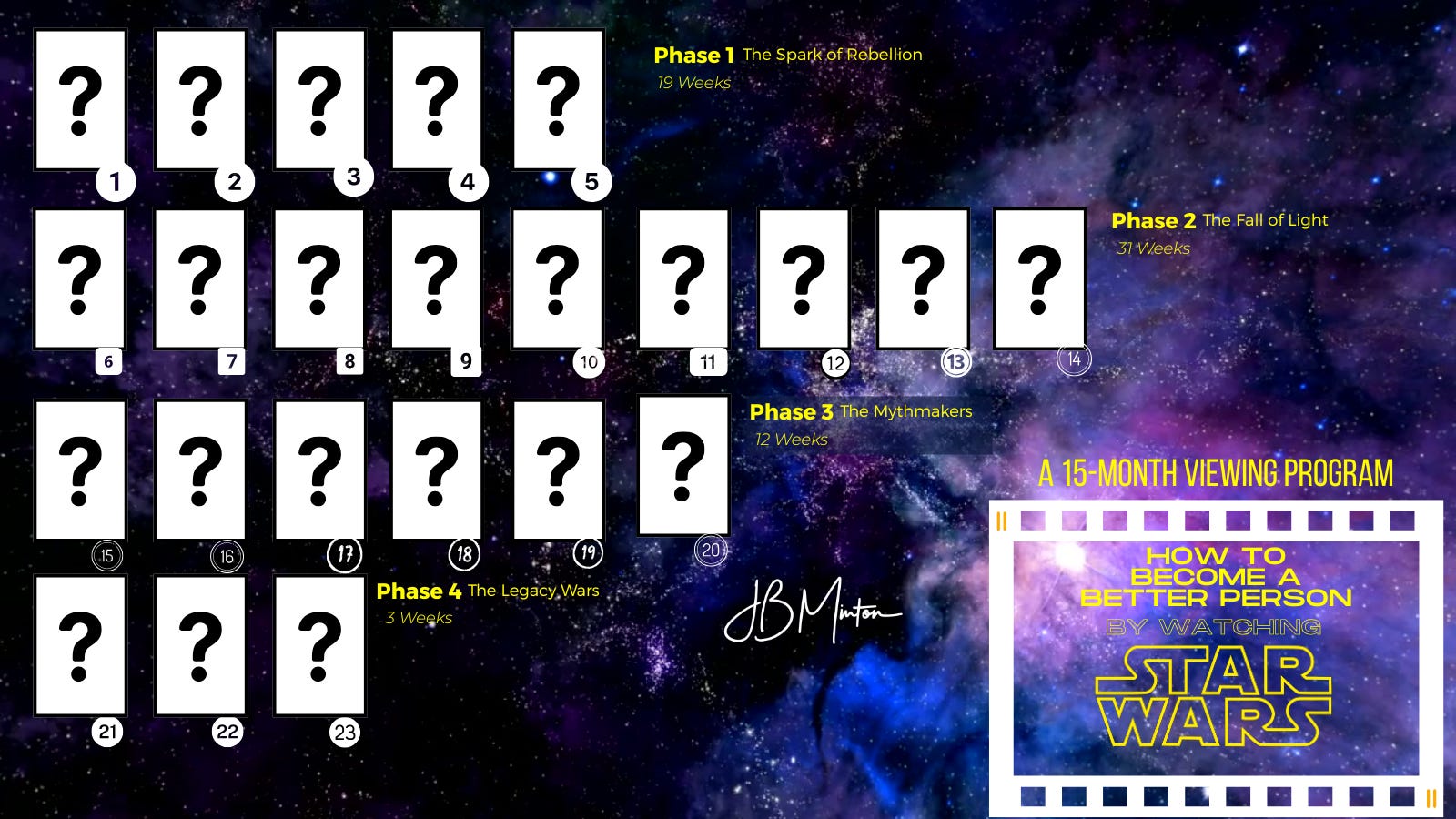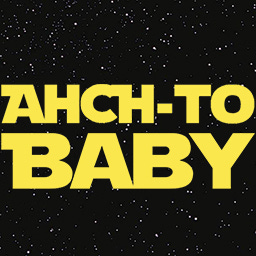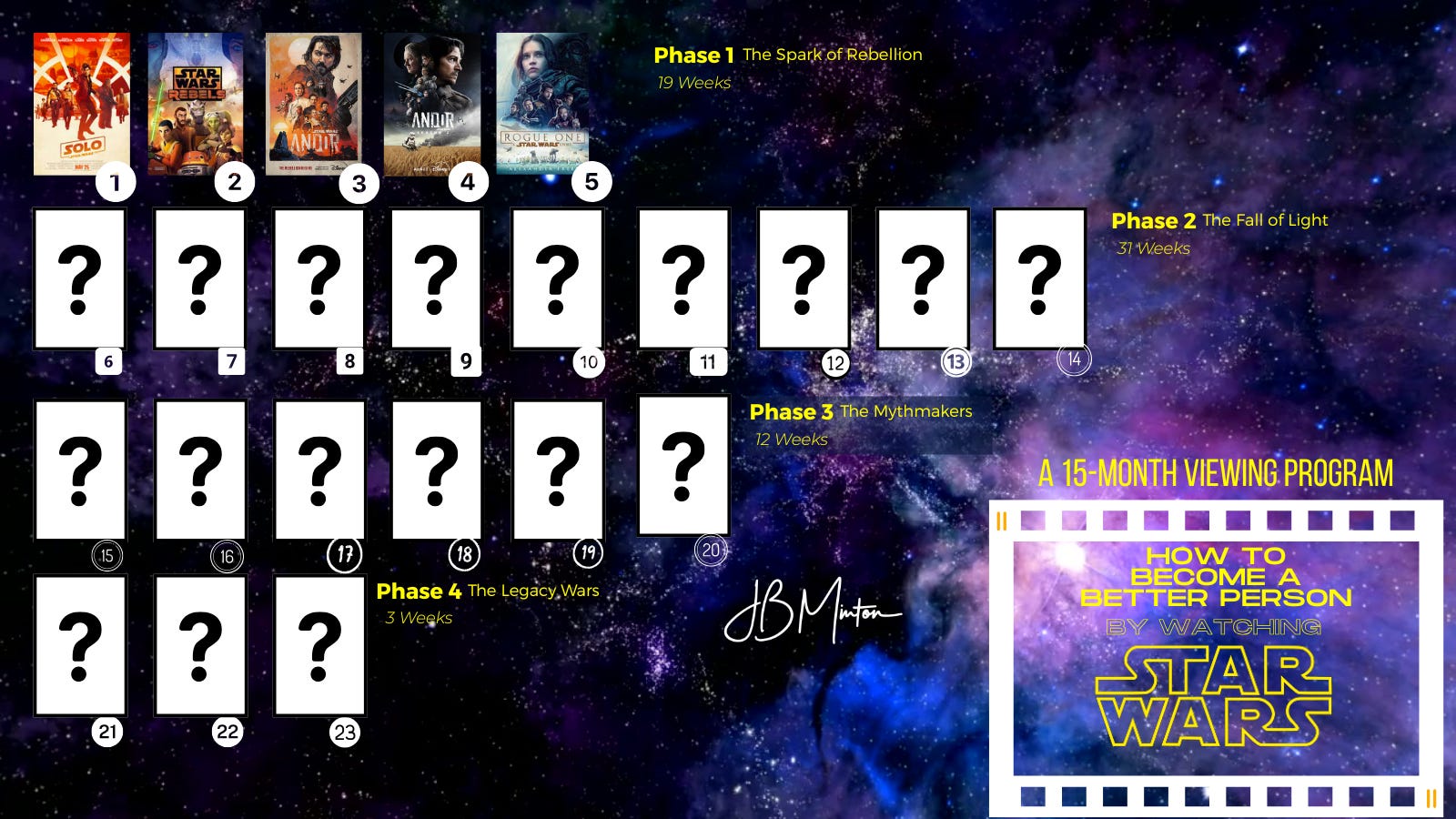[Paid Community] STAR WARS - A 15-Month Consciousness-Based Viewing Program
Getting Closer To Yourself Through A Galaxy, Far, Far Away...
I have experienced joy while watching Star Wars for nearly fifty years. I hope to pass on this flame of pleasure and knowledge by offering a suggested viewing program order for the Star Wars Cinematic, Animated, and Live-Action Serial Dramas. I also want to convey a set of moral and philosophical perspectives that I hope will bring you fulfillment through an exciting, multi-generational epic story, one you’ll spend nearly a year and a half of your life experiencing and reflecting on. This program is for the serious Star Wars enthusiast, not for those looking to waste time by watching a movie.
This program will offer you a deeper experience of the overall drama of the Star Wars universe, one that also reflects on the world we all live in together, while offering us metaphors we can use to discuss righteousness, virtue, fortune, love, and mercy; understanding these critical elements of not just living through our current challenges, but thriving in our bodies and minds. Understanding these vital factors of a functional society and a joy-filled life is essential to making the most of our brief existence as humans.
And I believe Star Wars, as commercial an enterprise as it’s become, still holds hope for those patient and sensitive enough to pay attention and learn.
BEGIN MarketingMessage1So, are you ready to commit to a 15-Month Star Wars viewing program?
All you’ll need is an active Disney+ subscription (or a library card and some patience) and will require three hours a week spent watching Star Wars.
And you will become a paid subscriber and get access to the whole program in this unlocked Substack post.
/END MarketingMessage1
Turning On The Empathy Machine: Understanding The Moral Value of Watching Movies And Thinking About Them
Movies are empathy machines.
Suppose the purpose of life is to gain experiences that lead to fulfillment. In that case, we must actively seek out as many experiences as possible to grow and develop our consciousness, thereby increasing our fulfillment. In the process of becoming fulfilled, we will experience happiness, and others will sense the joy radiating from within us.
Movies are an easy and effective way of gaining additional experience. As viewers, we can step into other worlds to see through different eyes, and every time we watch a movie, we add bits of consciousness, arranged in audio-visual narrative formats, to our own experiences. Essentially, the experience of watching a film is no different from having lived through the audio-visual experience presented on screen and through speakers.
And the best movies change who we are as people, hopefully for the better.
Movies aren’t just entertainment. Cinema delivers value to our lives beyond just filling and killing time. It is life-affirming to understand what creatures around us think and how their feelings influence their behavior in critical situations with much at stake. The best movies are these kinds of stories.
Creators of film strive to balance light and sound in the service of telling a story, passing along complex, tragic, and often hilarious narratives of experience that are deliberately composed constructions of consciousness, allowing every viewer to experience these stories from a unique perspective of differentiated personal experience.
Watching movies is a biological gift of art. Human eyes communicate information to our brains in just the right way, which, when projected onto a screen that moves at a consistent pace, recreates the drama of the never-lived moments (except in documentaries) in containers of captured information that can be replayed nearly forever.
Movies are humanity’s highest art form because they tell our stories and grant us the ability to learn through experiences that may have never happened, except on screen. Fiction on film is a special gift. We have the privilege of experiencing empathy and immersing ourselves in the minds and hearts of human beings on screen, navigating dire, tragic, and often hysterical situations.
BEGIN PublicServiceAnnoucementDuring this program, I encourage you to consider leaving your phone and other devices in the other room if possible. Take off your watch. Go away for a few hours. The world will wait for Star Wars.
/END PublicServiceAnnoucement
Like all conscious activity, there are three elements to watching movies:
The Viewer: You, as a conscious entity, focus all your energy of awareness onto a single object, the movie (including audio).
The Movie: What’s on screen and coming through the speakers.
The Process of Observation: Connects the viewer (you) with the movie.
The process of observation is our primary concern when we consider spending over thirty weeks of our time watching and thinking about all this commercial art. Is it worth your time? I think it is. I know from experience that watching and thinking about Star Wars can make you a better person, a better parent, a better spouse, a better friend, and a better neighbor and citizen. It’s never too late to learn to think and talk about Star Wars. And I want to help you sharpen that skill set, while we learn by sharing ideas in a supportive environment focused on growing in conscious awareness through the appreciation of art. As long as you stay respectful when sharing your thoughts, feelings, and beliefs with other Star Wars fans, you will have friends all over the world.
If you’ve read this far, you are likely a person who is passionate about films, and maybe you also love Star Wars, or perhaps you want to understand what the big deal is about this franchise, why all the dorks won’t ever shut up about the Skywalkers and their drama. You’re in the right place.
You may only be able to watch 30 minutes of Star Wars a day throughout the week. That’s okay. Or you may binge your weekly program assignments with an ice-cold beverage and a hot snack on a Sunday afternoon. That’s okay, too. It doesn’t matter; just get your viewing time in and be present with Star Wars for a few hours each week. The rest is letting your natural thoughts align with the art, allowing you to reflect on the characters and story situations between your viewing sessions. Keep Star Wars in the quiet of your mind and let the art roll around in your thoughts. Examine Star Wars from different angles, because it beats thinking about politics and worrying about the weather. After all, when we delve deeply into art like Star Wars, we can go deep enough to reveal ourselves to ourselves, and this is always a worthy expenditure of time, akin to abstracted self-therapy because we inevitably learn from what we focus on.
Human lives are collections of experiences, little boxes filled with bits of consciousness (observer + object + process of observation) packed together into meat containers that move around and run our mouths too much. However, when we actively watch movies, we sit, remain silent, and pay attention to what we see on screen and hear from the speakers. Think of movies as guided meditations delivered through sight and sound. When we watch a film with this level of intense awareness, we enjoy carefully crafted collections of experiences designed to convey narrative crises, telling a story with compelling characters, while expanding our consciousness with every film we watch.
A story told in the movie may be horrible, fantastic, or just informative. Still, cinema has the power to change everyone who actively watches and is open to new experiences on screen. The actively aware viewer understands that they are watching a movie, but also recognizes that they bring a unique set of experiences to the film. As a reward, the actively engaged viewer collects new experiences from the film to add to their life experiences. They hold the fantasy and the collected reality together in the same mind simultaneously, often with equal value.
That may sound impossible, but it’s true. Humans can hold conflicting ideas together in the same space and pretty close to the same time. The speed of thought limits the human mind in this function, which is how quickly we can mentally flip from one idea to the next; this is about as long as it takes a frame of film to advance and move the story forward. And each set of experiences informs the other.
When we watch a movie, we add that film’s collection of experiences to our own. And those experiences become part of us. Movies become part of us, especially the great ones. We each become more than we were before we watched the movie, and that’s the whole point of watching one to begin with, outside of seeking mindless entertainment.
Movies make actively aware viewers into better people, the deeper we look, and the more we watch them. Movies are tools to expand consciousness in real-time, emotionally, and through intellectual reflection. Whether a fictional character or a flesh-and-blood person, life is composed of creatures acting in critical situations with one another, and no life form acts in a void. Past experiences inform our current decisions, and we impact each other through behavior. Sometimes we impact with a hug and a kiss, and other times with weapons sharpened from tools meant for building.
There are numerous moral decisions made throughout Star Wars that correlate to nearly every aspect of our modern lives. We can think about Star Wars forever, but first, we need the entire experience (currently), and that is what this program seeks to deliver. Humans can project their thoughts through fictional narrative art and derive a moral analysis from the behaviors and consequences depicted on screen, which can then be applied to the never-ending news of the cruel world we unfortunately call “reality.”
Star Wars provides a fictional lens through which anyone can reconsider our world and our place in it. The goal of this 15-month viewing program is to ignite your self-respect, to focus your mind and heart together, and to activate your civic pride so that you can become a better person by watching and thinking about Star Wars.
A Long Time Ago…in 1977
The story of Star Wars is now much different and richer than when I first saw the movie on screen in the Summer of 1977. I was two years old, and I swear I remember it. My dad’s younger brother took me to see Star Wars one day when he was babysitting me, and I probably saw the movie for free because I was so small that I sat on his lap. I remember he told me that I shut up like a statue when the music started. I was an anxiety-riddled shit head of a toddler, but Star Wars always shut me up. Eventually, playing Star Wars also shut me up while I learned to tell my own stories within the small universe of Star Wars: Episode IV - A New Hope.
The first Star Wars film released remains elegant in its brevity, clarity, and simplicity. It will always work as a standalone cinematic experience, but the film also contains a wealth of subtext and historical context. Subtext refers to the underlying meaning or significance that exists beneath the surface of the story on the page or screen. Sometimes, subtext is hidden in dialogue, as when Obi-Wan reveals to Luke that his father was a great student of his, until the worst creature in the galaxy murdered him through an act of betrayal. A machine-man betrayed everything he once claimed to love and murdered the people he had sworn an oath to protect, and somehow that involved Luke’s father and his destiny to begin his life on the planet furthest from the center of the galaxy.
Another subtextual revelation in the original Star Wars movie is how it teaches all viewers about the horror of genocide. Everyone who has ever watched Star Wars understands that destroying a planet of peaceful people is an act of supreme evil. That act of terror, and the near glee with which Grand Moff Tarkin undertakes it, sets a standard for the viewer’s understanding of how sick this Imperial society has become, and why Luke must not miss the shot into the ventilator shaft.
On one level, Star Wars is a simple moral tale of redemption and personal growth. On another level, Star Wars is a deep political and philosophical movie that is far more than just a son coming to terms with the innumerable sins of his father. Star Wars is also a story about how bad things get when greed and cruelty fuel a never-ending lust for power, driven solely by the petty pursuit of accumulating corrupted wealth and engineering immortality at the expense of all matter and life in the universe.
Star Wars is ultimately about how moral corruption takes root and spreads like a spiritual cancer, first from within the heart of the most courageous protectors, when they fail to show up just when they are most needed, matched by Imperial machinery that feeds on atrocity, grievance, and suffering.
Star Wars is a story about how a republic falls into dictatorship and then back again, as the cycle of ignorance continues to prop up ancient, broken institutions that no longer represent the will of the people, and new institutions, incapable of governing because all they’ve known is war, come to an end. Governing with balanced justice is the goal of civil society. No society has ever fully achieved that goal, not even those in a galaxy far, far away.
One thing that becomes apparent in Phase 2 of this viewing program is that the Jedi f***ed it in Star Wars; they really messed up defending the galaxy, so that not even Yoda could stop what happened, because he didn’t see the Phantom Menace until it was too late. The Jedi, as an institutional army rooted in an ancient religion, was plagued by self-righteousness, hubris, ritual, and myopia. By Episode III, the Jedi were so deflated and distracted by the painful ruse of the Clone Wars engineered on both sides by Supreme Chancellor Palpatine that they couldn’t see their biggest enemy had them caged in from all sides for years.
Emperor Palpatine is arguably the most fantastic story villain of our modern age. Though he shares a deus with dark-hearted characters like Voldemort, Walter White, and Hannibal Lecter, each of whom is interchangeable when considering the reasons why bad people do bad things to others who don’t deserve it. Uniquely, Star Wars is also about how religions still have good things in their most secret ideological spaces. A possible lesson from Star Wars is that religions need to be set aside once the limitations of their silence are exposed, ejected like a rocket booster after the flame has burned out, and it is only now weighing down the command module.
However, I believe Star Wars is ultimately about the profound wisdom of letting go of the past to embrace the present living moment and the people who share it with us. We may not all be here tomorrow, but we’re here now, and we can act with discipline and affirmation. Affirmation without discipline is the beginning of delusion, and this is a lesson you can learn for yourself by watching Star Wars and paying attention.
Feel the Force. Let go of your conscious self and act on instinct.
- Obi-Wan Kenobi
I have put together a Star Wars viewing program. We won’t be watching it together physically, but we can watch it together asynchronously. No matter where you are in this viewing program, if paid subscribers offer their thoughts and experiences in the comments of this Substack essay, they will be responded to with respect and seriousness.
The Star Wars Cinematic, Animated, and Serialized universe is a vast project to watch, and it’s going to take a long time to complete, but it promises to be both fun and rewarding. You’ll feel like a kid again. Or maybe you’re lucky and you are still a kid in your heart. After nearly fifty years of watching Star Wars, I still love watching and discussing it with others. I don’t complain about Star Wars. I don’t love everything equally, but I love the overall story and how Star Wars has taught me moral lessons that I carry inside, along with those I learned from Mister Rogers, Little House on the Prairie, Star Trek, and hundreds of other shows, films, and novels. Art still matters to me.
I spent a good deal of time thinking about the best way to watch Star Wars, but I’m old enough now that I’ll only get to watch Star Wars completely like this once or twice more in my life. I want those viewing experiences to be meaningful by bringing me joy and helping me find comfort in the chaos of our world through the fictional lens of a universe supported by an all-powerful force of natural wisdom that can be channeled and manipulated through freedom of choice.
If this viewing program functions as intended, it will expand your consciousness and deepen your joy in life. Movies are magic, and we can all use a little bit of magic each week. Maybe we both enjoy watching Star Wars. Or perhaps you’re not currently a Star Wars fan, but you’re willing to learn and try to understand why this complex story has become so important to so many people worldwide. I’ll bet more people on Earth watch Star Wars than go to church or vote, and it’s because Star Wars brings us hope. That word “hope” is literally in the title of the first Star Wars movie the world watched. Star Wars will always be a new hope for every generation.
Some Logistical Details…
The first thing you should know is that this program does not adhere to the established release order of the cinematic, animated, and serialized timeline. Nor does this program follow the current chronological order of the narrative. We’re not starting at the beginning with Episode I, and I hope to convince you why that would be a mistake if we intend to enter each phase with the proper context to get the most from the overall narrative. Instead, consider these as segments of consecutive storytelling that we will gather into phases and rearrange to fit the purpose of exposing specific segments of the story in a particular order, thereby supporting a consciousness-based understanding of the narrative. You’ll learn about this as we proceed.
You won’t see Luke Skywalker for a long time when we start this program, not until Phase 2. You won’t know who Anakin is or why he was sent to bring balance to the Force. You’ll meet a few Jedi, but they’ll be monkish weirdos fighting battles they can’t possibly win. Or, maybe they can. When we arrive to meet those beloved later characters, you will have a deep and unique perspective with which to experience the space opera tragedy at the heart of Star Wars, and I think it will mean more to you because your conscious thoughts will be expanded.
And by the time we get to the end, you’ll have so many thoughts about Star Wars that you may never stop thinking about it again. And wouldn’t that be wonderful? It beats scrolling through angry politics on your phone and worrying about the cruelty of the weather.
Please consider this viewing program a weekly movie club, where paid subscribers can share their experiences throughout their viewing in the comments section.
RECOMMENDATIONS:
Consider these other fine publications where Star Wars is intelligently and respectfully discussed.
Wherever you are in this Star Wars viewing program, please consider an annual subscription and share your experiences in the comments as you engage with this great art of Star Wars.
REPEAT MarketingMessage1So, are you ready to commit to a 15-Month Star Wars viewing program?
All you’ll need is an active Disney+ subscription (or a library card and some patience) and will require three hours a week spent watching Star Wars.
Become a paid subscriber and get access to the whole program in this Substack post.
/END MarketingMessage1
Phase 1
PHASE 1 THE SPARK OF REBELLION:
“Ordinary Heroes, Impossible Odds”
The beginning of our Star Wars viewing program isn’t about chosen ones or ancient prophecies. It’s about thieves, spies, orphans, and soldiers who are forced to decide whether survival is enough. Solo, Rebels, Andor, and Rogue One show us how the galaxy’s “nobodies” and “has beens” are the only ones who can make tyranny bleed, and that’s because they have nothing to lose from resistance and everything to gain.
BEFORE THE BATTLE OF YAVIN (BBY) / AFTER THE BATTLE OF YAVIN (ABY)
The Battle of Yavin is where Luke Skywalker blows up the first Death Star. This is a critical milestone in Star Wars, and we will use it as a reference point in time to understand the chronological order of events.
We begin Phase 1 around 13 BBY, during the cold period that follows the fall of the late Republic and the Rise of the Empire. This is a time of great suffering and danger. The galaxy is controlled by a merciless beauracracy that runs on suffering, corruption, terror, and death, all feeding into the ever-consuming will of a Dark Lord of the Sith. But we don’t understand any of this yet. At the beginning of our Star Wars viewing program, we see people who are hungry and barely surviving, yet they are remarkably skilled in combat and intelligent. Han Solo is a survivor…
Enjoy this conversation with Jeff K of The Death Star Human Resources Department Newsletter, recorded in October, 2025.







